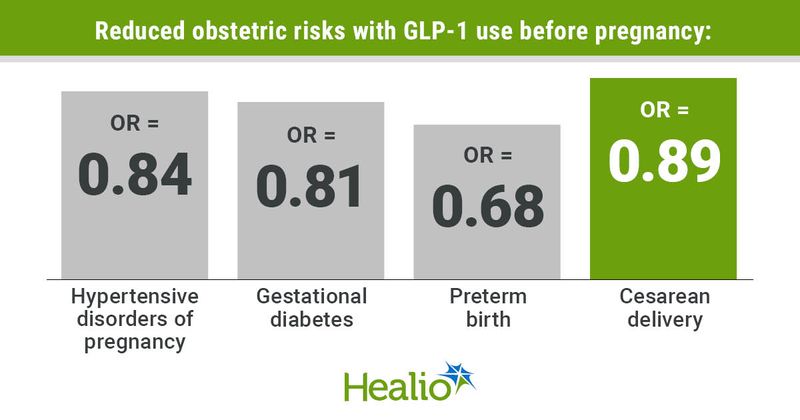Preconception GLP-1 receptor agonist use may reduce pregnancy risks
Key takeaways:
- GLP-1 receptor agonist use before pregnancy was tied to lower risks for hypertensive disorders of pregnancy and gestational diabetes.
- GLP-1s were also tied to lower risks for preterm and cesarean births.
Women prescribed a GLP-1 receptor agonist up to 2 years before conception were less likely to develop hypertensive disorders of pregnancy, gestational diabetes, have a preterm birth or cesarean delivery, researchers reported.
“Relatively little is known how preconception GLP-1 receptor agonist use may impact pregnancy outcomes,” Christopher T. Nau, MD, assistant professor in the department of reproductive biology at Case Western Reserve University School of Medicine and the division of maternal fetal medicine at University Hospitals Cleveland Medical Center, told Healio. “This study suggests that [GLP-1s] may have potential to be a powerful tool to optimize preconception health.”

The findings were published in the American Journal of Obstetrics and Gynecology.
In a retrospective study, Nau and colleagues analyzed electronic health records for 8,534 women with a history of pregnancy, using data from the U.S. Collaborative Network within the TriNetX platform. Researchers compared women who did or did not receive a GLP-1 receptor agonist prescription within 24 months of pregnancy, matching the two groups by age, race, ethnicity and history of comorbid conditions.

The primary outcomes were rates of hypertensive disorders of pregnancy, gestational diabetes, preterm birth and cesarean delivery between the two cohorts.
Researchers found that women who received a GLP-1 receptor agonist prescription before pregnancy were less likely to develop hypertensive disorders of pregnancy (19.9% vs. 22.8%; OR = 0.84; 95% CI, 0.76-0.94), gestational diabetes (15.2% vs. 18.2%; OR = 0.81; 95% CI, 0.72-0.91), have a preterm birth (3% vs. 4.4%; OR = 0.68; 95% CI, 0.54-0.85) and undergo cesarean delivery (17.6% vs. 19.7%; OR = 0.89; 95% CI, 0.87-0.97) compared with women who did not receive a prescription. Researchers observed similar trends in analyses restricted to women who received a GLP-1 receptor agonist prescription within 12 months of pregnancy.
“The gestational diabetes and hypertensive disorders of pregnancy composites as well as gestational hypertension continued to be significantly decreased even at prescriptions within 6 and 3 months of pregnancy,” the researchers wrote.
In a separate analysis, researchers also found that women who received a prescription for the dual-agonist tirzepatide (Mounjaro/Zepbound, Eli Lilly) up to 24 months before pregnancy had a 45% lower risk for cesarean delivery compared with those who received a prescription for a GLP-1 receptor agonist (OR = 0.55; 95% CI, 0.37-0.83).
“GLP-1 receptor agonists are not recommended to be used during pregnancy, and so we can assume that the vast majority, if not all, of patients had stopped use either before or soon after conception,” Nau told Healio. “The association we found of improved obstetric outcomes was seen despite having stopped the medication months before most of these complications would arise.”
Researchers noted that the observational study relied on diagnosis codes and they could not track whether patients took GLP-1 receptor agonists as prescribed.
“The next step would be to prospectively study patients prescribed GLP-1 receptor agonists to confirm the associations we saw in this study,” Nau told Healio.
For more information:
Christopher T. Nau, MD, can be reached at christopher.nau@UHhospitals.org.


